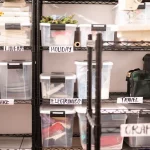You might feel that the messiness in your house isn’t messiness in any way. However, mess comes in various flavors — six to be careful. Some messiness should be cleansed, tossed out, given, or sold. Other mess just can be kept, tidied up, and put away. Yet, it very well may be hard to figure out what things in your house are which sorts of messiness and what to do about each.
Here are six types of home clutter with tips on what to toss or keep.
Clutter Without a Place
:max_bytes(150000):strip_icc():format(webp)/how-to-use-plastic-storage-containers-2648422_hero_3225-3b0d01b943064b91a4677c42f6c28162-e507391050a24beaa589506d8c7ea54b.jpg)
The Spruce / Margot Cavin
Some of your clutter is stuff you do want to keep without a doubt but the items don’t yet have a place to call their own. You may have unopened items or things that simply need a sliver of storage space. The best way to handle items that you know you’ll use is to store them neatly in labeled, clear plastic containers. Some items that fall into this category could include:
- New books you haven’t opened or read
- Seasonal items you bought on sale
- Items you purchased for gift-giving in the near future
Trash Masquerading as Clutter
:max_bytes(150000):strip_icc():format(webp)/6-quick-tips-to-control-clutter-and-stop-hoarding-2648657-06-bf372a84ea8046ca9cf50a0de0047a36-329850fb53a64b69ab0cadb7af12ace0.jpg)
The Spruce / Letícia Almeida
What is considered clutter and what is considered trash? It’s important to know the difference so you can establish strict rules for yourself on how long you’ll keep an item before tossing it out. For example, you may have a pair of trousers that need hemming, but you haven’t brought the pair of pants to the tailor for more than a month. Maybe you don’t want or need those pants anymore. It’s okay to donate them if that’s the case.Here are just a few other items that you might consider as trash:
Bargain Items You Never Needed
:max_bytes(150000):strip_icc():format(webp)/pack-toiletries-in-carry-on-bag-2648341-recirc-fea0474e032547c2a744b66e799e44df.jpg)
The Spruce / Olivia Inman
Who can resist a good store sale, yard sale, goody bag, or a promotional gift with a purchase? Even if something is free or too good to pass up, why bring it into your home? If you’re never going to use it or gift it, the item wasn’t a bargain. Tag sale “bargains” and promotional swag bags full of products from the mall or business conferences can easily turn into clutter. If you immediately have someone in mind you can gift the item, and pick it up. If not, there’s no use taking it in as clutter.
Buying in Bulk to Make You Feel Safe
:max_bytes(150000):strip_icc():format(webp)/pantry-organization-ideas-2648624_01-bddba7e0584f4e1aabbbbc6d3cb89b37.jpg)
The Spruce / Kevin Norris
Buying items in triplicate or bulk because you think you may get caught short may result in large amounts of products that go unused. It’s called “abundance clutter” because having many products makes you feel secure. It also makes you feel as though you are taking good care of your family. Stocking up and buying in bulk is not always bad. If you have a large freezer why not take advantage of deals on meats and frozen foods you know you’ll eat? There are also many items you’ll inevitably use without thinking twice, such as paper goods. However, think twice before stocking up on some fresh foods, pet foods, toiletries, clothing, and decor for many reasons:
- Items may attract rodents and insects
- Ingredients could expire and spoil
- Your tastes and size could change
- Items can go out of style
Aspirational Clutter for the Future
:max_bytes(150000):strip_icc():format(webp)/coffee-table-styling-ideas-4126581-hero-38707eaeb9f141bebf84c70661940755-e1c5ff03a2f24709bc15d729476fb050.jpg)
The Spruce / Christopher Lee
Aspirational clutter is the stuff you accumulate to help you change, to develop a skill, or to appear differently to others. For example, if you’ve ever purchased a glamorous “coffee table” book to keep on display, but never actually read it, you may have fallen victim to aspirational clutter. Or, you may have purchased a set of golf clubs in anticipation of taking up the sport but realized you didn’t like the game after the first lesson. The best way to banish this type of clutter is to have a conversation with yourself before purchasing the item. What about if you are determined to change your entire home’s style of decor? If you are just about to buy a drastically different style sofa, first ask yourself these questions to get clear on your intentions:
Why do you truly want to change your style of decor?
What attracts you to the style?
Can you first rent furniture in that style?
Where are you going to put your current furniture?
Sentimental Clutter From the Past
:max_bytes(150000):strip_icc():format(webp)/get-rid-of-sentimental-clutter-4126430_hero_3237-90a04c7a8c354854941e31cee8746d5f-04c933f8c3e84168afea9793953dca90.jpg)
The Spruce / Margot Cavin
If you hesitate to toss your baby blanket or your mother’s formal dinner set that you never use, you’re holding on to items that have nostalgic meaning. Sentimental clutter is the hardest clutter to eliminate. You may look at letting go of this type of clutter as an act of betrayal toward a loved one. Or, you may think you’re turning your back on a fond memory or meaningful time in your life. You can part with sentimental clutter by following these steps:
Look at the item and decide if it’s usable or needs to be fixed in some way.
Are you willing to fix broken parts or replace missing pieces?
Choose a few important items to hold onto as mementos and donate or hand down the rest.
Take photos of items before donating.
Display a small number of items, such as photos or mementos, which will alleviate the guilt over tossing the rest.
Credit: TheSpruce









